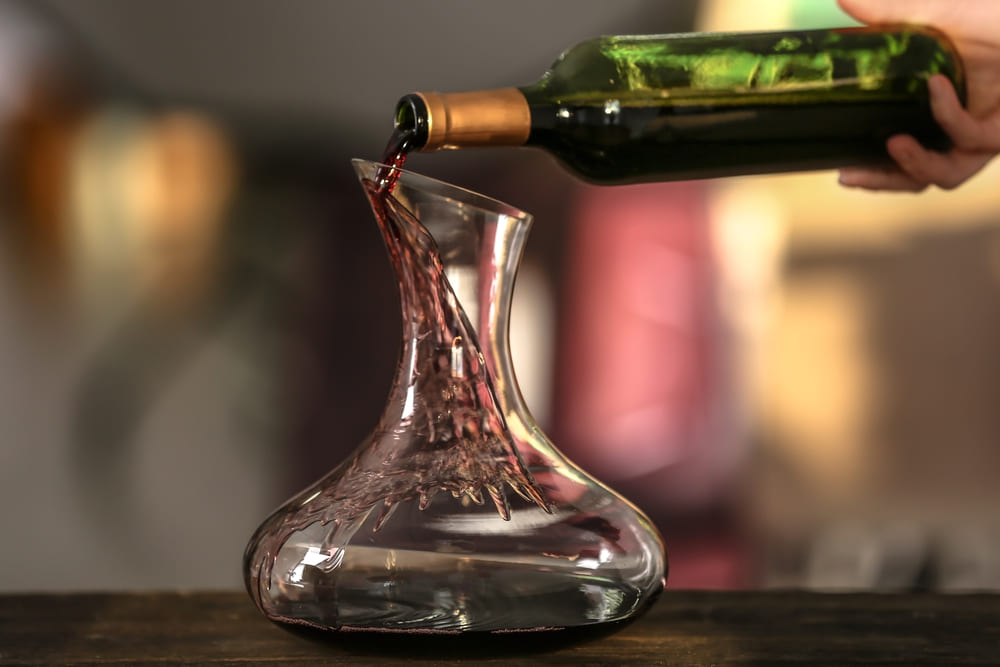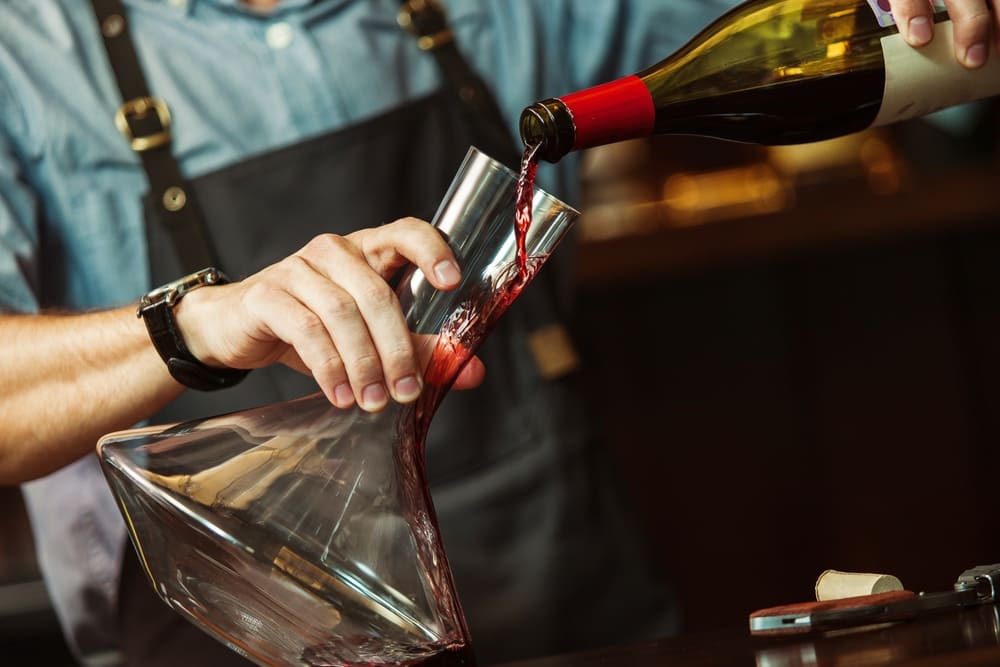A decanter can help take your wine game to the next level. But exactly what does a decanter do for wine? Decanting is an aeration process that removes unwanted sediment and softens harsh tannins and acids to improve the wine’s flavor. Plus, serving wine from a decanter elevates the drinking experience for you and your guests.
Keep reading to learn more about what a wine decanter does and how to use one to achieve the best results.
What Is a Wine Decanter?
A wine decanter is a glass vessel used for aerating wine before consumption. The average wine decanter holds one standard size bottle of wine (.75 liters) and features a tall, narrow neck and a wide base. The neck is roughly 30cm tall while the base’s bowl is roughly 30cm wide. The bowl’s large surface area allows for maximum oxygen exposure, which allows for better decantation.

What Does A Wine Decanter Do?
The Purpose of a Wine Decanter
A wine decanter is used for three main purposes. Decanters are designed to:
- Aerate Wine: The main purpose of a decanter is to aerate the wine poured into it. The aeration process allows the wine to breathe to enhance its flavor profile. When wine is poured into a decanter, it’s exposed to oxygen. Oxidation reduces the presence of tannins and acids in the wine, giving it a smoother taste.
- Separate Wine From Sediment: Decanters also separate the wine from the sediment. Red wines in particular often contain sediment leftover from the bottling process. This sediment not only gives the wine a bitter taste but also looks unappetizing in a wine glass. Decanting these wines makes the wine taste and look better by making sure the sediment remains in the wine bottle.
- Store Wine: While decanters are primarily used to aerate wine and eliminate unwanted sediment, they’re also a great way to store wine for serving. Whether you’re enjoying a solo wine night or having friends over for dinner, pouring your wine into a decanter adds a certain degree of ambiance to the occasion.

Which Wines Should Be Decanted?
Older wines, complex young wines, and most red wines benefit from being decanted. Older wines and red wines often contain sediment that must be separated from the wine itself, and young wines generally need more time to aerate to allow their flavors to fully develop.
But not all wines should be decanted. Sparkling wines, for example, shouldn’t be decanted because carbon dioxide escapes during the oxidation process, which causes the wine to lose carbonation. Rosés and many white wines also shouldn’t be decanted because they don’t have rich, complex flavors that require aeration. These wines are best served straight from the bottle due to their juicy and aromatic flavor profiles. Plus, a cool serving temperature is best for these wines, and decantation brings wine to room temperature.
How To Decant Wine
Wondering how to use a wine decanter? It’s simple. All you have to do is follow these three steps:
- Stand the bottle you want to decant on a flat surface for 24 hours. This will allow the sediment to settle at the bottom.
- Once it’s time to decant, carefully open the bottle and pour its contents into your decanter. The key here is to pour low and slow to prevent the sediment at the bottom from entering the vessel.
- Once you’ve poured most of the wine into the decanter, set the bottle down. You’ll want to leave the last bit of wine in the bottle to keep out any sediment.

How Long To Decant Wine
Every bottle of wine is different and requires a different amount of decanting. Here are a few guidelines to help you out.
- Full-bodied reds such as Cabernet Sauvignon, Syrah, and Malbec are best enjoyed after one to two hours of decanting.
- Other red wines such as Cabernet Franc, Merlot, and Pinot Noir only need 30 to 45 minutes of decanting.
- Young wines should be decanted no more than one hour before being consumed given their shorter aging period.
- Wines that are more than 10 years old shouldn’t be decanted for more than about 30 minutes. That’s because the purpose is to separate the sediment rather than aerate the wine.
- Some white wines can be decanted, but the decanting time shouldn’t exceed 15 or 20 minutes to prevent spoiling.
Whatever you do, don’t decant your wine for too long. Doing so could cause the signature flavors and aromas to over-oxidize, which will result in spoiled wine.
How To Decant Wine Without A Decanter
Don’t have a decanter? Don’t worry. A pitcher, carafe, flower vase, large bowl, or even a few pint glasses are all great substitutes.
You’ll follow the same three decanting steps described above in addition to rinsing the leftover sediment from the empty wine bottle and pouring the aerated wine back into the bottle right before serving. This “double decanting” process ensures proper aeration and sediment removal for the best wine-drinking experience.
Get Your Favorite Wines for Less With The Wine Cellar Group
Ready to taste the difference a decanter can make? Grab your favorite reds and whites from our signature Cellar Collection to get started. You can order wine by the bottle or stock up with a case at a time—whatever you prefer. Place an order online today to get your favorite wines at a discounted price. We’re offering 15% off four bottles, 35% off 12 bottles, and 45% off 24 bottles. Just add to cart, and the discount will auto-apply at checkout.






Leave A Comment